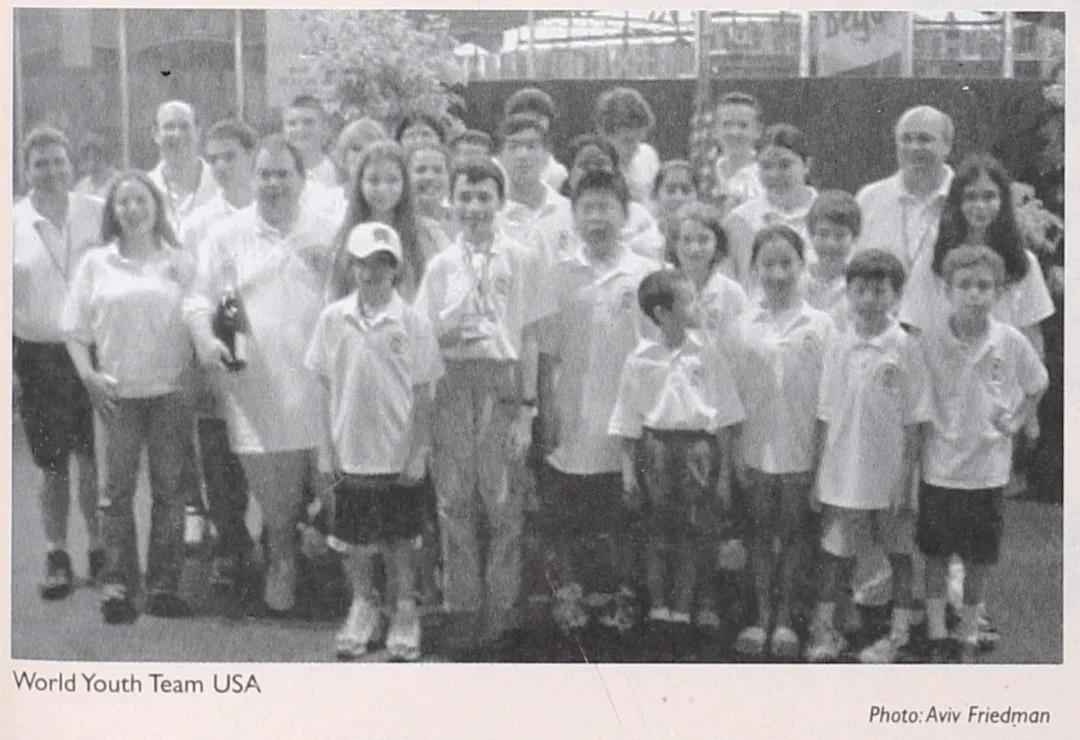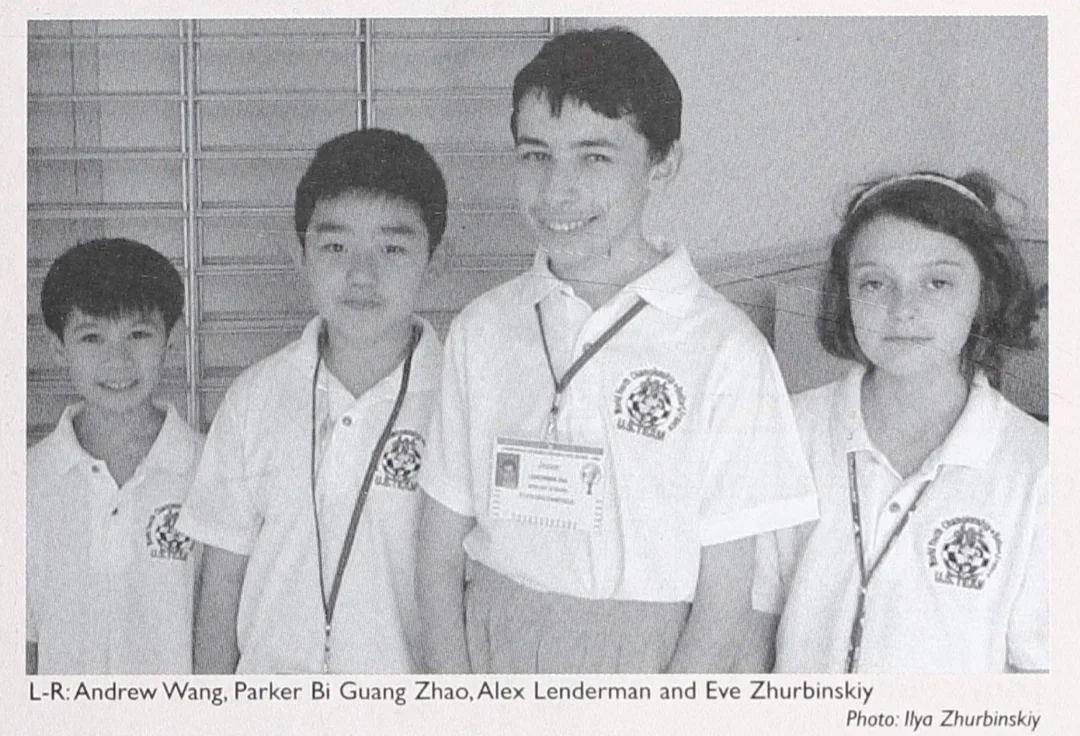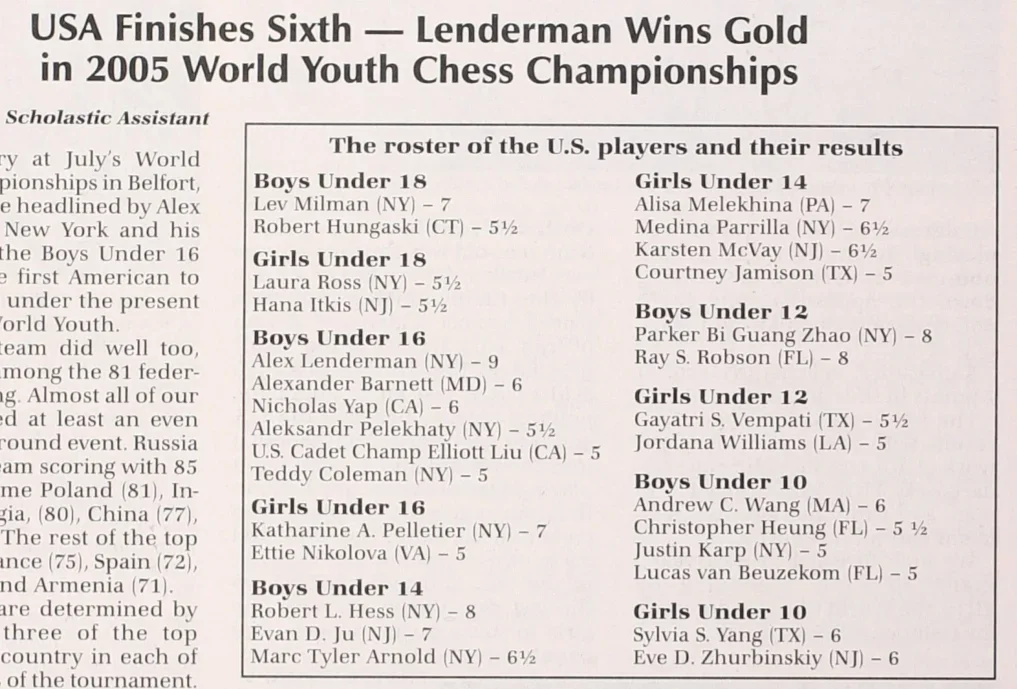
Many happy returns continue from the 2005 World Youth Championships, when the U.S. delegation sent 31 players to Belfort, France and produced several noteworthy performances for a sixth-place team finish out of 81 federations.
Nearly every U.S. player managed at least an even score in the 11-round event, including at least three players who went on to become Grandmasters and US Chess superstars, and are now currently competing for a spot in next year’s US Chess Championship -- GMs Alex Lenderman, Robert Hess and Daniel Naroditsky.
None were shining brighter than 15-year-old Lenderman, who stormed the Boys U16 section in Belfort and became the first American World Youth Champion in over a decade. The New Yorker turned in a scorching performance scoring 9/11, an even-more impressive tally considering a slow 2.5/4 start -- and a 6.5/7 closing streak to earn the gold medal.

Only a FIDE Master at the time, Lenderman picked the right event to be punching way above his belt, including this victory in the penultimate round over then-IM Ian Nepomniachtchi from Russia, who eventually earned the silver medal in 2015 and went on to be today’s No. 4 player in the world.
[pgn][Event "Belfort WYCC Boys U16"] [Site "?"] [Date "2005.??.??"] [Round "10"] [White "FM Lenderman, Alex (2378) "] [Black "IM Nepomniatchtchi, Ian (2502) "] [Result "1-0"] [ECO "B90"] [WhiteElo "2378"] [BlackElo "2502"] [Annotator "FM Aviv Friedman"] [PlyCount "105"] 1. e4 c5 2. d4 cxd4 3. Nf3 {This move order was designed to create the illusion that maybe Alex will play the Smith Morra Gambit he sometimes uses.} d6 {[3 ... e5 is bad, not because of: 4 Nxe5?? Qa5+, but rather because of 4 c3! with a great version of the Gambit.]} 4. Nxd4 Nf6 5. Nc3 a6 {Not a surprise, of course.} 6. Be3 e5 7. Nb3 Be7 8. f3 Be6 9. Qd2 Nbd7 10. O-O-O O-O 11. g4 Nb6 {This is Black's pet line in the Najdorf. We went over some of the main games and the ideas, and so Alex felt quite confident.} 12. h4 Qc7 13. Kb1 Rfc8 {As usual, with castling on opposite sides, each player mobilizes his forces towards the opponent's king.} 14. g5 Nfd7 15. Rh2 {A good move, which both prepares a possible doubling of the rooks and also defends the second rank — specifically, the c2-pawn} Nc4 16. Bxc4 Bxc4 17. Nd5 {Previously, Black had this position against Russian GM Alekseev, where White played: [17 h5 a5 18 Ncl b5 and only then 19 Nd5. That game was drawn, after a short battle.]} Bxd5 18. Qxd5 a5 19. a4 {An unusual measure to prevent both ... a4 and ... b5.} Qc4 {A not-so-obvious mistake. After the game Ian told Alex he had this position before and played 19 ...Qc6. Now Alex jumps on an opportunity:} 20. Qxb7 Qxa4 {For a moment it may seem like Black is doing fine but now comes a shocker:} 21. Nc5 {A nice trick after which White has an advantage.} Nxc5 {[21 ... Rxc5? 22 Bxc5 Nxc5 23 Qxe7 21 ... dxc5 22 Qxd7 Qxd7 23 Rxd7 With complete domination.]} 22. Qxe7 Na6 {Black wants to play ... Nb4, but Alex is well prepared:} 23. b3 Qb5 24. Rhd2 {Not a bad move but 24 g6! might have been even stronger: 24 ... hxg6 P4 ... fxg6 25 Qe6+ Kh8 26 h5 looks strong too.) 25 h5 gxh5 26 Rgl! With a huge attack.} Nb4 25. Qxd6 {With the idea of playing 26 Qd8+!} h5 {25 ... Nc6! was forced here. Although after 26 Qc5 White is much better.} 26. g6 fxg6 {A mistake in a bad position.} 27. Qxg6 {White menaces 28 Rd7, and if a black rook moves from the 8th rank, 28 Rd8+ is curtains.} Nxc2 {A last, desperate try} 28. Qe6+ {An important, in-between move, which holds to the b3-pawn.} Kh8 29. Rxc2 Rxc2 30. Kxc2 Qe2+ 31. Bd2 { All that is left is for Alex to consolidate and not hang anything. The rest is easy:} a4 32. bxa4 Qxf3 33. Qc4 Qg4 34. Bc3 Rc8 35. Qd5 Qg2+ 36. Rd2 Qg3 37. Qd3 Qxh4 38. a5 Qe7 39. Qd6 Qe8 40. Qd7 Qg8 41. Rd5 Qf8 42. Qf5 Rxc3+ 43. Kxc3 Qa3+ 44. Kd2 Qb2+ 45. Ke1 Qc1+ 46. Rd1 Qc3+ 47. Kf1 Qc4+ 48. Kg1 Qc5+ 49. Kh1 Qxa5 50. Qxh5+ Kg8 51. Qg5 Kh7 52. Qh4+ Kg8 53. Qd8+ 1-0 [/pgn]
The October 2005 issue of Chess Life, or specifically the backpage section “School Mates,” which would later become Chess Life for Kids, features a U.S. roster studded with lasting star power, and a great interview of the world champion Lenderman by U.S. delegate coach FM Aviv Friedman. Some juicy reveals by Lenderman includes his not having a regular coach (“It costs a fortune.”) and one of his tournament secrets being long walks to the tournament venue with his grandfather.
Lenderman also describes his chess work ethic coming from playing many OTB tournaments but, in 2005, he had also started to find benefits from a lot of “on-line blitz” chess.
“Playing online allows you to try out lines and pick up ideas for openings you could later apply in tournament chess, so it helps,” said Lenderman in 2005. Today, the GM sits a half-point off the lead in the first-ever online qualifier for the US Chess Championship.
Lenderman also nails prophecy with a bit of game recognizing game, when Friedman presses the 15-year-old on who to watch from the younger generation: Lenderman picks Ray Robson, who scored 8/11 to finish fifth in the Boys U12 section and is now firmly in the top-100 players in the world; and also picks Daniel Naroditsky, who scored 7/11 in the U10 section for fifth place. Lenderman and Naroditsky are currently tied in the US Championship Online Qualifier, and fought to a draw on Wednesday.
Also appearing in both the 2005 World Youth delegation and the online qualifier to next year's national championship is GM Hess. Now a popular high-profile commentator on chess.com, Hess scored 8/11 in Belgrade and finished fifth place in the boys U14 section.
All three GMs Lenderman, Naroditsky and Hess have since competed in a US Chess national championship event, with Lenderman joining a three-player playoff to decide the champion in 2014.

Categories
Archives
- January 2026 (4)
- December 2025 (27)
- November 2025 (29)
- October 2025 (39)
- September 2025 (27)
- August 2025 (29)
- July 2025 (43)
- June 2025 (25)
- May 2025 (24)
- April 2025 (29)
- March 2025 (29)
- February 2025 (20)
- January 2025 (24)
- December 2024 (34)
- November 2024 (18)
- October 2024 (35)
- September 2024 (23)
- August 2024 (27)
- July 2024 (44)
- June 2024 (27)
- May 2024 (31)
- April 2024 (51)
- March 2024 (34)
- February 2024 (25)
- January 2024 (26)
- December 2023 (29)
- November 2023 (26)
- October 2023 (37)
- September 2023 (27)
- August 2023 (37)
- July 2023 (47)
- June 2023 (33)
- May 2023 (37)
- April 2023 (45)
- March 2023 (37)
- February 2023 (28)
- January 2023 (31)
- December 2022 (23)
- November 2022 (32)
- October 2022 (31)
- September 2022 (19)
- August 2022 (39)
- July 2022 (32)
- June 2022 (35)
- May 2022 (21)
- April 2022 (31)
- March 2022 (33)
- February 2022 (21)
- January 2022 (27)
- December 2021 (36)
- November 2021 (34)
- October 2021 (25)
- September 2021 (25)
- August 2021 (41)
- July 2021 (36)
- June 2021 (29)
- May 2021 (29)
- April 2021 (31)
- March 2021 (33)
- February 2021 (28)
- January 2021 (29)
- December 2020 (38)
- November 2020 (40)
- October 2020 (41)
- September 2020 (35)
- August 2020 (38)
- July 2020 (36)
- June 2020 (46)
- May 2020 (42)
- April 2020 (37)
- March 2020 (60)
- February 2020 (38)
- January 2020 (45)
- December 2019 (34)
- November 2019 (35)
- October 2019 (42)
- September 2019 (45)
- August 2019 (56)
- July 2019 (44)
- June 2019 (35)
- May 2019 (40)
- April 2019 (48)
- March 2019 (61)
- February 2019 (39)
- January 2019 (30)
- December 2018 (29)
- November 2018 (51)
- October 2018 (45)
- September 2018 (29)
- August 2018 (49)
- July 2018 (35)
- June 2018 (31)
- May 2018 (39)
- April 2018 (31)
- March 2018 (26)
- February 2018 (33)
- January 2018 (30)
- December 2017 (26)
- November 2017 (24)
- October 2017 (30)
- September 2017 (30)
- August 2017 (31)
- July 2017 (28)
- June 2017 (32)
- May 2017 (26)
- April 2017 (37)
- March 2017 (28)
- February 2017 (30)
- January 2017 (27)
- December 2016 (29)
- November 2016 (24)
- October 2016 (32)
- September 2016 (31)
- August 2016 (27)
- July 2016 (24)
- June 2016 (26)
- May 2016 (19)
- April 2016 (30)
- March 2016 (36)
- February 2016 (28)
- January 2016 (32)
- December 2015 (26)
- November 2015 (23)
- October 2015 (16)
- September 2015 (28)
- August 2015 (28)
- July 2015 (6)
- June 2015 (1)
- May 2015 (2)
- April 2015 (1)
- February 2015 (3)
- January 2015 (1)
- December 2014 (1)
- July 2010 (1)
- October 1991 (1)
- August 1989 (1)
- January 1988 (1)
- December 1983 (1)







